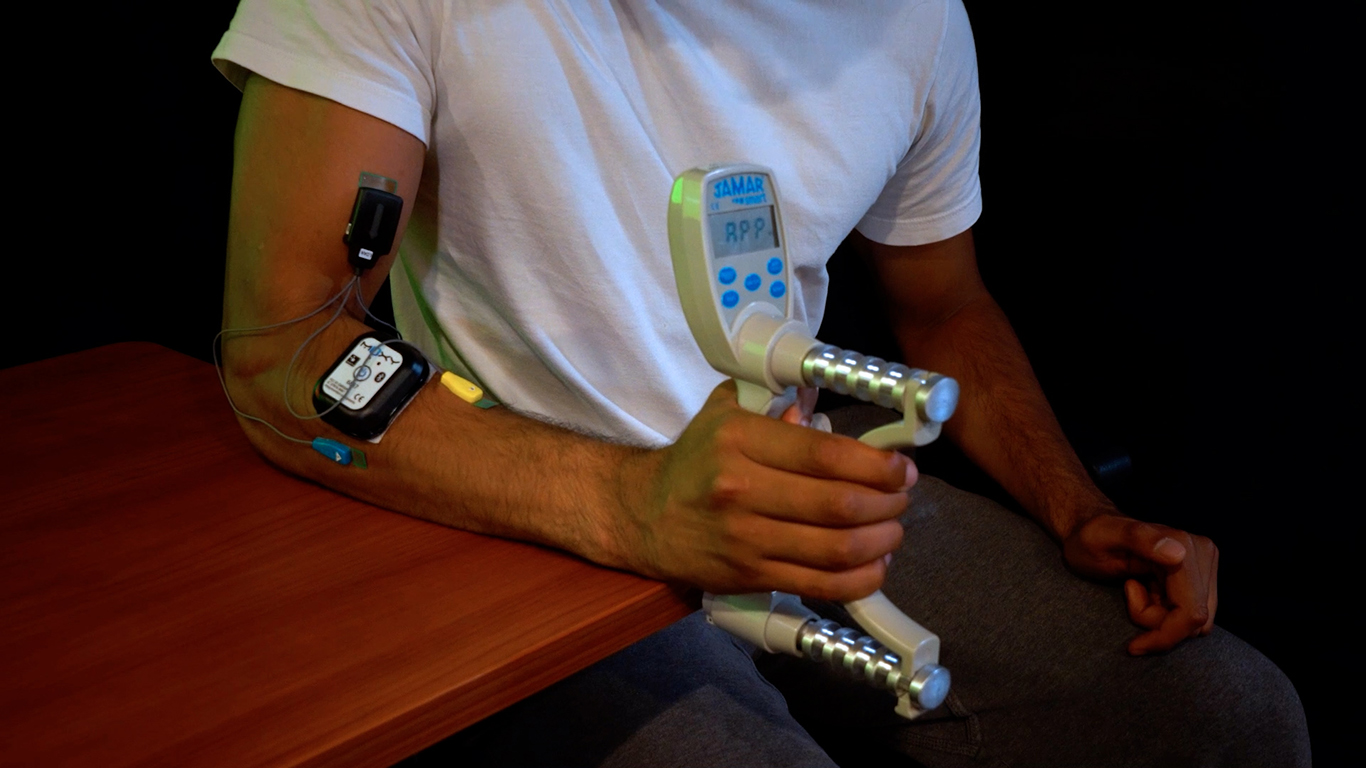Background
Muscle fatigue can be defined as a transient decrease in the capacity to perform physical actions, essentially a person’s inability to exert maximum muscle force. Cumulative muscle fatigue can lead to musculoskeletal disorders, therefore monitoring it is significant. Tracking fatigue benefits the promotion of muscle performance and growth in athletics and can also be used to prevent exercise intolerance during rehabilitation.
Surface electromyography (EMG) is an experiment-based method used to measure localized muscular fatigue. It is a non-invasive procedure, resulting in little to no discomfort for the subject. Power spectral variables of the EMG signal have proven to decrease while sustaining a muscle contraction. This relationship provides a basis for surface EMG to be used effectively to identify muscular fatigue levels.
keywords: muscle fatigue, electromyography, mean frequency, accelerometry


Collaborative Study
A recent study performed by Dr. Haiwei Dong and Dr. Abdulmotaleb El Saddik collaboratively at the University of Ottawa and New York University Abu Dhabi1 utilized surface EMG and accelerometry to create a fatigue-tracking system of whole-body movements. A total of seventeen subjects performed two different experiments; holding their body weight in dip-start position for 1 minute and curling a gender-specific weight with their right arm every 2.5 seconds during a 1 minute span. Surface EMG and accelerometer signals were collected from the subjects’ biceps brachii, triceps brachii and anterior deltoid using a Delsys Trigno™ wireless EMG system.
The group calculated the mean frequency of the EMG signals in order to analyze fatigue, due to its low sensitivity to noise2. The EMG signals that were collected identified localized fatigue. These localized recordings allowed the group to construct an overall fatigue measurement of the human body movements. Overall fatigue was viewed as a dynamic process, meaning a prior fatigue level will affect the real-time fatigue level. To incorporate this, a custom statistical analysis computation was designed which updated overall fatigue with the most recent surface EMG recordings. For the periodic movements, which made up the arm curling data, the filtered accelerometer data was used to extract precise active EMG signals. These extracted signals were then connected so that the fatigue analysis did not include any recovery muscle activity, thus it could be treated as a sustained contraction.
Conclusion
Surface EMG is a painless, non-invasive procedure which produces data that can be used to measure muscular fatigue levels. The collaborative study conducted by Dr. Haiwei Dong and Dr. Abdulmotaleb El Saddik created a successful wireless fatigue-tracking system for human body movements. This system treated fatigue as a dynamic process and updated fatigue levels with the most recent measurements. The system was proven by performing two different experiments with 17 subjects, where each fatigue level was found to be negative. The level of fatigue was then confirmed by subject feedback, as it correlated directly to the magnitude of the fatigue measurements.
References
- Haiwei Dong, Izaskun Ugalde, Nadia Figueroa and Abdulmotaleb El Saddik, “Towards whole body fatigue assessment of human movement: A fatigue-tracking system based on combined sEMG and accelerometer signals,” Sensors (Basel), vol. 14, no.2, pp. 2052–2070, 2014.
- Haiwei Dong, Izaskun Ugalde and Abdulmotaleb El Saddik, “Development of a fatigue tracking system for monitoring human body movement,” in Proceedings of IEEE International Instrumentation and Measurement Technology Conference, pp. 786-791, 2014.
- www.delsyseurope.com
Delsys EMG Systems
Delsys EMG systems feature wired and wireless surface EMG sensors designed to produce a reliable, consistent EMG signal with low muscle crosstalk and reduced motion artifact. The wireless sensors allow the subjects to move freely and without exerting any unnecessary energy. The wireless sensors also contain tri-axial accelerometers, used to track sensor motion.
The Study Parameters
Subject in dip-start position, hold for 1 minute
Weighted arm curl every 2.5 seconds for 1 minute
The Study Focus
Surface EMG and accelerometry data collection from:
- Biceps branchii
- Triceps branchii
- Anterior deltoid
Mean frequency analysis
Statistical analysis
Delsys Instruments Used in the Study
16 sensor Trigno™ Wireless EMG System
16 channel Bagnoli™ Desktop EMG System





